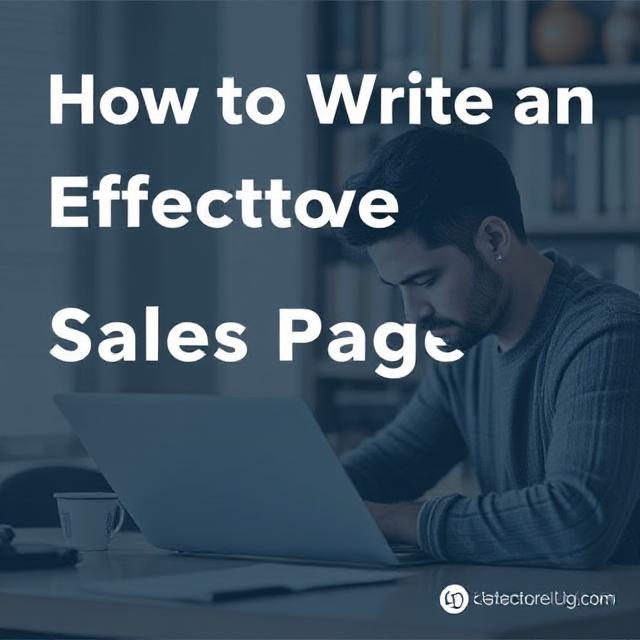
A well-crafted sales page can be the difference between a visitor bouncing off your site and a customer making a purchase. In today’s highly competitive digital world, writing an effective sales page is crucial for any business aiming to generate leads and drive sales. Whether you’re selling a physical product, digital service, or promoting a subscription plan, understanding how to structure and optimize a sales page can significantly boost your conversion rates.
In this article, we’ll explore the key steps to creating a sales page that grabs attention, builds trust, and compels action.
What Is a Sales Page?
A sales page is a standalone webpage designed to persuade visitors to take a specific action—most commonly to purchase a product or service. Unlike a typical webpage that may offer general information, a sales page has one primary goal: convert visitors into customers.
Key Elements of an Effective Sales Page
An effective sales page is a carefully crafted combination of persuasive writing, compelling visuals, and strategic design. Below are the essential components:
1. Attention-Grabbing Headline
Your headline is the first thing visitors will see. It must capture their attention immediately and convey the core benefit of your offer.
- Example: “Lose 10 Pounds in 30 Days Without Giving Up Your Favorite Foods!”
- Keep it clear, concise, and benefit-driven.
2. Compelling Subheadline
The subheadline reinforces your main headline and offers additional detail to keep the reader engaged. This is where you start hinting at how you’ll solve the reader’s problem.
3. Clear Value Proposition
Answer the question: What’s in it for the customer? Your value proposition should explain how your product or service will solve a specific problem or improve the reader’s life. Focus on the unique features that set you apart from competitors.
4. Engaging Introduction
Your introduction should highlight the pain points your audience is experiencing and promise a solution. Show empathy and demonstrate that you understand their needs.
- Pro Tip: Use storytelling to create an emotional connection.
5. Bullet Points for Benefits and Features
Most readers will skim the page, so break down your product’s key benefits and features using bullet points.
- Focus on benefits, not just features.
- Feature: “Cloud-based storage with 1TB capacity.”
- Benefit: “Access your files anytime, anywhere, without worrying about running out of space.”
6. Social Proof (Testimonials, Reviews, and Case Studies)
Building trust is essential for conversions. Include real testimonials, success stories, or case studies to show how others have benefited from your offer.
- Use photos, names, and specific results to make the testimonials more credible.
7. High-Quality Visuals and Design
A visually appealing sales page enhances credibility and engagement. Include:
- Product images or demo videos
- Clean, uncluttered design
- Consistent brand colors and typography
8. Overcome Objections
Address common concerns or objections that may prevent visitors from converting. These could include price, trust issues, or concerns about results.
- Example: “If you’re not satisfied, we offer a 30-day money-back guarantee—no questions asked.”
9. Clear and Persuasive Call-to-Action (CTA)
Your CTA is the most important element of your sales page. Make it:
- Action-oriented: Use phrases like “Get Started Now,” “Claim Your Free Trial,” or “Buy Today.”
- Visible: Use a contrasting color and repeat the CTA throughout the page.
10. Urgency and Scarcity
Adding urgency or scarcity can significantly boost conversions. Limited-time offers, countdown timers, and low-stock warnings encourage visitors to act quickly.
- Example: “Offer Ends in 24 Hours!”
How to Structure Your Sales Page
Here’s a proven structure to follow when creating your sales page:
- Headline and Subheadline – Grab attention.
- Introduction – Empathize with the reader and present the problem.
- Product Introduction – Introduce your solution and its unique value.
- Benefits and Features – Use bullet points to highlight what the reader gains.
- Social Proof – Include testimonials and case studies.
- Offer Details – Explain pricing, discounts, and guarantees.
- Call-to-Action (CTA) – Prompt the reader to take immediate action.
- FAQ Section – Address common questions and concerns.
- Final CTA – Reinforce urgency and the main benefits.
Tips for Writing Persuasive Copy
- Focus on the customer: Avoid talking too much about your company. Instead, center your copy on how your offer benefits the reader.
- Use emotional triggers: People make buying decisions based on emotions and justify them with logic.
- Write conversationally: Avoid overly technical jargon. Write like you’re speaking directly to your target audience.
- Test and optimize: A/B test different headlines, CTAs, and page designs to see what converts best.
Common Mistakes to Avoid
- Being too vague: Always be specific about your product’s benefits and features.
- Overloading with information: Keep the message simple and focused.
- Weak CTA: A vague or generic CTA can reduce conversions.
- Ignoring mobile optimization: Ensure your sales page looks great on all devices.
Examples of Successful Sales Pages
To inspire you, here are a few well-known examples:
- Dropbox: Focuses on simplicity and benefits, with a clear CTA and strong social proof.
- Shopify: Offers a free trial with a bold CTA and testimonials to build trust.
- Basecamp: Uses storytelling to connect emotionally with the reader while highlighting features.
Creating an effective sales page takes time, research, and creativity. By focusing on the key elements—attention-grabbing headlines, compelling value propositions, and persuasive CTAs—you can turn casual visitors into loyal customers. Remember to test and optimize your page regularly to ensure you’re getting the best results.
Start implementing these strategies today, and watch your sales grow!

